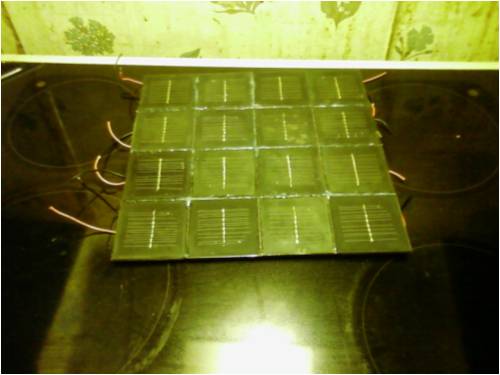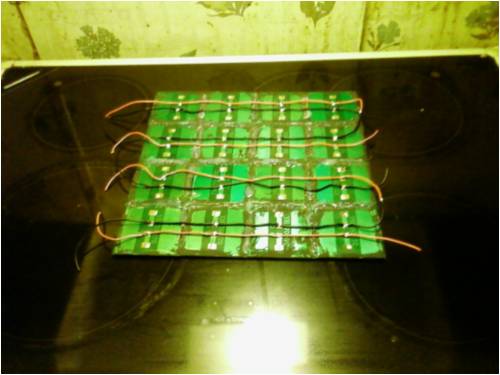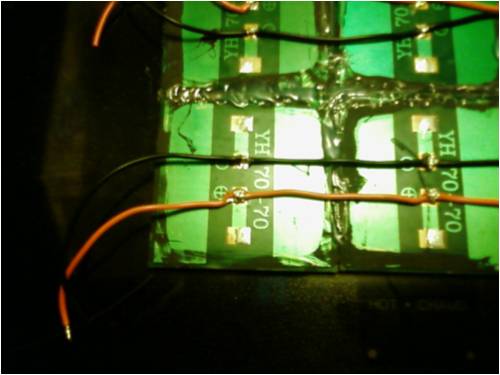
|

|
Forum Index : Solar : homegrown project
| Author | Message | ||||
| readyakira Senior Member Joined: 17/07/2008 Location: United StatesPosts: 114 |
So, over the last few days I came up with this idea to make a small solar panel of my own for battery charging. I'm not expecting to make anything big enough to charge a bank of batteries, but maybe enough to keep a charge in say my riding lawnmower battery. So I have been collecting all the solar landscape lights I can get my hands on. So far I have about 20 of them. the other night I soldered about 16 of them in a 4parralel but 4 series combo. This gave me about 16v in moderate sun 12v in cloudy conditions. But the amperage is very small at about 90milliamps. So I hope to continue collecting these till I can aquire enough to fill a piece of 8x4' plywood. Maybe then I can get enough to be usefull. anyone tried this before? Any success stories to tell? Don't you think Free/Renewable energy should be mandatory in new buildings? |
||||
| Gizmo Admin Group Joined: 05/06/2004 Location: AustraliaPosts: 5015 |
Good idea. You wouldn,t expect too much from those solar lights, but for keeping a lawn mower ( bike, ATV, car) battery topped up they should be fine. I think 90ma would be enough for the lawn mower. A car is a different case, there is usually something drawing a few ma, like a clock radio or the ECU. You would need to measure the cars total drain with a amp meter to see how much solar is needed to keep it topped up. Glenn The best time to plant a tree was twenty years ago, the second best time is right now. JAQ |
||||
| readyakira Senior Member Joined: 17/07/2008 Location: United StatesPosts: 114 |
I'll have to get some pics up someplace to show how simple the design of what I did was. Of course my phone is a POS so I will have to use the misses since mine has destroyed my mem card and takes 16 color photos for some reason. Don't you think Free/Renewable energy should be mandatory in new buildings? |
||||
Gill Senior Member Joined: 11/11/2006 Location: AustraliaPosts: 669 |
G'day readyakira, Some time ago I read where the preferred solar panel voltage was around 18 to 21 volts open circuit. Can't recall why that is so. I know all my BP ans Solarex panels are up higher than the 16 volts you use. As I say I can't recall why but it may be something to keep in mind with your project. Good luck with it. Great idea. was working fine... til the smoke got out. Cheers Gill _Cairns, FNQ |
||||
| GWatPE Senior Member Joined: 01/09/2006 Location: AustraliaPosts: 2127 |
The MPP voltage is related to the open cct voltage and the type of cell. Most crystalline solar cells have a MPP voltage of between 0.72 and 0.82 of the open cct voltage. Amorphous solar cells have a much broader knee point on the VI curve, and the MPP voltage is around 0.6 to 0.65 of the open cct voltage. GalliumArsenide and hybrid silicon cells are different as well. The optimum operating voltage can be determined by varying the load and producing a VI curve. This will be for a particular temperature. I would suggest that you match cells with the same current in the same series string. The open cct voltages should then be as closely matched when connecting these strings in parallel. Mixing cells with non matching current will degrade the series string output. You may end up with different numbers of cells in each series string for the open cct voltage matching. When cells are made into panels in a factory, the individual cells are graded before connecting in series. The higher quality panels with the highest output are those where the current and voltage are higher. You may get 10% more power if the cells are sorted. This may be a waste of effort if there is no MPPT though. Gordon. become more energy aware |
||||
| Dinges Senior Member Joined: 04/01/2008 Location: AlbaniaPosts: 510 |
You have 200 of those PV modules ? How did you get them all? 'Harvesting' from people's gardens at night?  Just kidding. Just kidding.
I have taken a few of those modules apart too. They're basically consumer gadgets that people buy because they look like a good idea and are cheap, but turn out to have disappointing performance and get tossed. The idea of those lamps is good, the implementation is lousy though. My cells are 4.5V (open) and 60mA (shorted). I have about half a dozen I'm saving but haven't found a good use for them yet. What you're doing is a bit like making a shirt out of 1x1" patches of material. Impressive. 
When your PV panel is finished it'd be nice to see a photo of it. At least I'm curious as to how it looks. Peter. |
||||
| readyakira Senior Member Joined: 17/07/2008 Location: United StatesPosts: 114 |
Well, I deliver appliances for a living and when I see someone with the solar yard lights I always ask if they want to give them away. 9 out of 10 times they have dead batteries in them and the people are more then happy to get them out of their yard. I don't have 200 yet LOL that was a typo it should have read 20! HA 200 and I should have been in business.... I will try to get the misses to let me use her phone tonight to take a few pics since mine is fubar. I'll post my 16 cell arrangement for you to see. I tried to design it to be expandable as you will see in the photo. Delivering appliances has also gotten me 2 of those F&P motors that everyone is making into wind turbines. Tonight I am going to work more on my VAWT design but I will get the pics up ASAP. I'm a bit confused on what gwatpe was talking about with the different voltages but I will try to get more info on the voltages it can produce. Don't you think Free/Renewable energy should be mandatory in new buildings? |
||||
| readyakira Senior Member Joined: 17/07/2008 Location: United StatesPosts: 114 |
Here are a few of the pics I promised. The first shows the collector part of the cells all glued and stuck together. I am not sure how the hot glue will work, but there are many many options for this iin the future if needed. 
This one is of the back side and you can kind of see how the wiring was done. Looking thru posts it looks as if I am connecting the cells wrong so I will have to try a different arrangement tomorrow. I designed it to be easy to switch if need be. I am running 4 cells in parrallel and connecting each of those groups in series. Looks as if I should do it the other way around from what I have been reading on the forums. 
The last one is just a close-up of one of the cells I used in this arrangement. I had 17 of these that were identical and as such this is why this panel is no bigger then this so far. 
Don't you think Free/Renewable energy should be mandatory in new buildings? |
||||
| Dinges Senior Member Joined: 04/01/2008 Location: AlbaniaPosts: 510 |
Ah. It's more like making a handkerchief than a shirt then. 
No project is complete without hotglue. 
I'm not sure if the hotglue will be able to withstand the hot temperature the cells may reach when in full sun. Time will tell, I suppose. You should be able to get much more current than 90mA I think. The cell I tested yielded 60mA in a short, so should yield about 50mA in normal operating conditions. Putting four of my cells in parallel should yield about 200mA. Your cells look exactly the same as mine. You may have a few weak cells in there that lower the performance of your entire panel. Especially in PV panels goes that 'a chain is only as strong as its weakest link'. You should test the cells individually for output and select the best ones. That is what Gordon was trying to tell you. I very much like the idea of making something useful out of stuff others have thrown away. Peter. |
||||
| readyakira Senior Member Joined: 17/07/2008 Location: United StatesPosts: 114 |
well, I will have to check each cell individually then. when I check them I am using a dmm I can just place the meter in the mA scale and check pos to neg right? no load needed? Should I wire the cells in series then join the groups parallel? I guess that I could just have it wired wrong. Don't you think Free/Renewable energy should be mandatory in new buildings? |
||||
| Dinges Senior Member Joined: 04/01/2008 Location: AlbaniaPosts: 510 |
Correct. In this case your DMM is the load. You don't need any other load for this test. You should number all cells from 1-16. Then, for each cell individually(!) (this means you'll have to remove your current wiring), measure short-circuit current. Write it down for each cell. Let's assume this is the result: 70-65-60-55-50-45-40-35-30-25-etc. mA Then, start grouping cells in batches based on quality ('selecting'): the 4 cells with the highest current will have to become one series string. In the above example, wire the 70mA cell, the 65, 60 and 55 mA ones in series. This will become one chain. Current in this chain will be limited to 55mA by the lowest-grade cell. Do the same again with the left-over cells: again select the 4 that have the highest current, in this case, the 50-45-40-35 mA cells. This will be your next chain, limited to a current of 35mA. (in this example). Etc.etc., till you don't have any cells left. By then you have 4 chains (each chain consisting of 4 cells); parallel those chains. Following this procedure will yield the maximum possible output of your cells. However, if it turns out that there's very little variation in your cells (unlike the example above) and all yield about the same current, then I'd simply rewire it back into its present configuration. No need to go through all the special wiring for just a few mA gain, in that case. Peter. Edit: No. |
||||
| readyakira Senior Member Joined: 17/07/2008 Location: United StatesPosts: 114 |
thanx for that write up. That should be a sticky somewhere. I will have to work on that tonight. Don't you think Free/Renewable energy should be mandatory in new buildings? |
||||
| craig sparks Newbie Joined: 01/01/2009 Location: United StatesPosts: 3 |
Try http://www.wildnaturesolutions.com/ they probably have what you're looking for... wildnaturesolutions.com |
||||
| craig sparks Newbie Joined: 01/01/2009 Location: United StatesPosts: 3 |
Check out these guys! They probably have or can get just about everything you need for your project and great prices,,,, http://www.wildnaturesolutions.com/ wildnaturesolutions.com |
||||
| howlet Newbie Joined: 18/01/2009 Location: United StatesPosts: 2 |
I built a small shop that is dedicated to DIY solar panels. In order to fabricate quality panels I had to purchase an inexpensive laminator (flebay) and use the industry standard Tempered Glass/EVA/Tedlar configuration. Probably more work/expense than the average DIYer wants to invest but my panels are very professional looking and perform as well as any commercial panel. Will post photos if anyone is interested. JB RE is great therapy for an idle mind |
||||